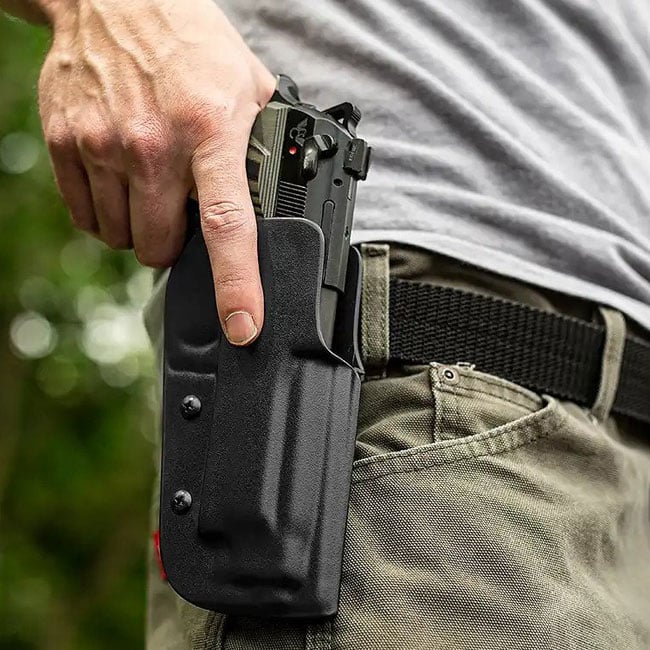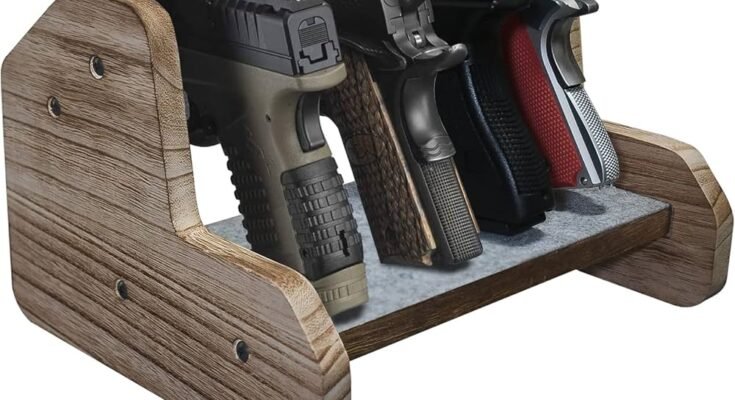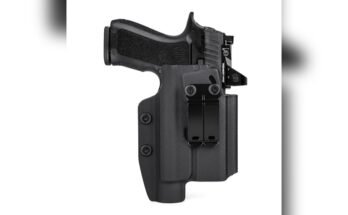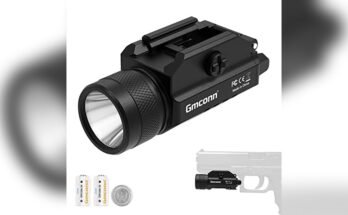I’ve spent years testing holsters on the range, in classes, and during daily carry. Here’s the short answer: a gun holster is a secure carrier that holds a firearm in a fixed position for safe, fast access. It protects the trigger, supports comfort, and manages retention so the gun stays put until you draw. In this guide, I’ll break down what a gun holster is, how it works, what to choose, and how to use it well. If you’re asking “What is a gun holster?” you’re in the right place.

What Is A Gun Holster?
A gun holster is a purpose-built holder for a firearm. It keeps the gun stable, covers the trigger, and allows a safe draw. The best holsters balance three things: safety, comfort, and access.
Holsters are used for concealed carry, duty use, competition, and home or field carry. The design changes based on your purpose. But the core job is the same: keep the gun secure and ready when you need it.

Key Parts And How A Holster Works
A holster may look simple, but small details matter.
- Shell: The main body that shapes to your firearm. It protects the trigger guard and controls retention.
- Mounting system: Clips, loops, wings, or paddles that attach to your belt, waistband, or platform.
- Sweat guard: A raised section that keeps the slide off your skin and helps guide reholstering.
- Cant and ride height: Angle and vertical position help concealment, comfort, and draw speed.
- Retention: Passive molding or active devices like hoods or buttons that hold the gun in place.
On the draw, retention releases with your grip and motion. On reholster, the shell should stay open and stable. Good holsters make this smooth and safe.

Holster Materials And Their Trade-Offs
Material affects safety, durability, and comfort.
- Kydex: Rigid, durable, and low maintenance. Precise fit and crisp retention. Can feel hard against skin.
- Leather: Classic, comfortable, and molds over time. Needs care. Watch for mouth collapse on older models.
- Hybrid: Kydex shell with a leather or synthetic backer. Good comfort with positive retention. Check hardware often.
- Nylon or fabric: Light and budget-friendly. Often less rigid. Use only if it fully covers the trigger and holds shape.
From my experience, Kydex excels for consistent draws and training. Leather feels great for all-day wear if maintained. Hybrids balance both for many users.
Understanding Retention Levels
Retention is how tightly the holster holds your gun.
- Passive retention: Friction or a molded click around the trigger guard or slide. Common for concealed carry.
- Active retention: A strap, hood, or button that you must release. Often used for duty or open carry.
- Levels (often called Level I, II, III): More levels mean more devices. Higher levels protect against gun grabs.
Pick retention to match your use. For concealed carry, a well-tuned passive holster is often best. For duty or open carry, consider higher levels.
Carry Methods And Positions
The “where” matters as much as the “what.”
- Inside the waistband: AIWB (appendix, front of the body) and strong side hip are common. Great concealment. Needs a good belt and holster wedge or wing.
- Outside the waistband: Comfortable and fast. Better for range, duty, or jacket cover.
- Pocket: Small guns only. Use a pocket holster that covers the trigger and keeps the gun upright.
- Shoulder: Niche use with proper cover garments and training.
- Chest or chest rig: Useful for hiking or field work with backpacks.
Tip from the field: test positions at home with an unloaded gun. Sit, stand, drive, and tie your shoes. If it prints or pokes, adjust.
Choosing The Right Holster
Match the holster to your gun, body, and goals.
- Fit: Exact model fit beats “one size fits most.”
- Trigger coverage: Non‑negotiable. No gaps near the trigger guard.
- Access: Full firing grip in the holster. If you must adjust after the draw, pick another model.
- Comfort: Look for wedges, wings, and smooth edges. Hot spots mean you’ll stop carrying.
- Adjustability: Retention screws, cant, and ride height help fine-tune.
- Belt: A stiff belt changes everything. It distributes weight and stabilizes the draw.
I keep two setups: one for long days at the desk and one for active days. Your routine may need more than one holster.
Finding The Right Size And Fit
Fit drives safety and consistency.
- Test retention: Hold the empty holster upside down with the gun unloaded. It should not fall out easily.
- Check mouth integrity: The opening must stay rigid for safe reholstering.
- Confirm optics and light fit: Many guns now run red dots and lights. Use a holster built for your setup.
- Clothing check: Try your normal wardrobe. If you must size up one shirt size, that can be normal for some carry styles.
Small adjustments add up. A quarter inch change in ride height can fix hotspots and printing.
Safety, Training, And Good Habits
Safety comes first, always.
- Keep your finger off the trigger while holstering and drawing.
- Reholster slow and clear. Do not force the gun into the holster.
- Watch for clothing or cords near the trigger guard.
- Practice draws with an unloaded firearm. Add live fire only after dry practice feels smooth.
- Use safe storage at home. A holster is not a lock.
From classes I’ve coached, most mishaps happen on reholster. Slow down. If anything feels off, stop and reset.
Maintenance And Care
Holsters need attention too.
- Inspect hardware: Tighten screws. Use thread locker if recommended.
- Clean the shell: Dust and lint collect inside. Wipe with a damp cloth.
- Check belt clips and loops: Replace if cracked or bent.
- Leather care: Keep it dry, conditioned, and firm. Replace if soft near the trigger area.
- Test retention monthly: Things loosen over time.
A five-minute check prevents big problems at the worst time.
Legal And Ethical Considerations
Laws vary by state and city. Know yours.
- Understand where carry is allowed and banned.
- Some sites require specific holster types for training or events.
- If you carry in public, ensure your holster covers the trigger and retains the gun during normal movement.
- Be mindful of printing in places where it causes alarm.
Regulations change. Check current statutes and training updates before you carry.
Common Mistakes To Avoid
Learn from hard-won lessons.
- Buying on price alone. Cheap gear often fails at the clip, not the shell.
- Using a soft, floppy belt. It ruins even the best holster.
- Ignoring comfort. If it hurts, you won’t wear it.
- Reholstering fast. There is no prize for speed here.
- Using a one-size holster for a gun with a light or optic.
I’ve made each mistake once. Only once.
Quick Buyer’s Checklist
Use this before you click buy.
- Exact fit for your firearm, including light and optic.
- Full trigger guard coverage.
- Adjustable retention and ride height.
- Solid clip or loops that match belt width.
- Rigid mouth for safe reholstering.
- Proven maker with clear specs and support.
If a holster passes every item, you’re on the right track.
Frequently Asked Questions Of What Is A Gun Holster?
What does a gun holster actually do?
It holds your firearm in a fixed, safe position, covers the trigger, and lets you draw on purpose. It also improves comfort and protects the gun from sweat and bumps.
Is Kydex better than leather?
Neither is always better. Kydex is rigid and low maintenance with consistent retention. Leather is comfortable and classic but needs care and can soften over time. Choose based on your use and upkeep.
What is the safest carry position?
The safest position is the one you can manage well with good training and a proper holster. Many prefer appendix or strong-side hip for control and speed, but you must practice safe draws and reholsters.
Do I need a special belt for carrying?
Yes. A stiff belt supports the holster, reduces printing, and makes the draw consistent. It is one of the biggest upgrades you can make.
How tight should holster retention be?
Tight enough that the unloaded gun does not fall out when the holster is inverted, but not so tight that you struggle to draw. Adjust to the point where your first grip clears the holster smoothly.
Can one holster fit multiple guns?
Some can, but exact-fit holsters are safer and more reliable. If a holster is “universal,” verify full trigger coverage and proper retention on your exact gun.
How often should I replace my holster?
Replace it if the mouth collapses, hardware cracks, retention fails, or it no longer covers the trigger well. Many quality holsters last years with care.
Wrap-Up And Next Steps
A gun holster is more than a holder. It is a safety tool that balances secure retention, fast access, and daily comfort. Choose a holster that fits your firearm and your life. Train slow, practice often, and check your gear. Small upgrades, like a better belt or a tuned ride height, can transform your carry.
Take action today. Review your current setup. Run the buyer’s checklist. Try a short dry practice session with safe handling. If you found this helpful, subscribe for more guides, leave a question, or explore our other resources.



